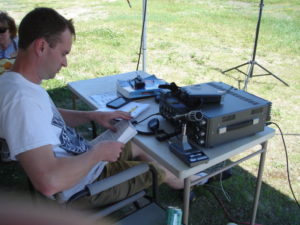________________________
What Is Ham Radio
- Making new friends
- being on a first name basis with people all around the world
- learning new things
- emergency communications when the power is out and cell phones don’t work
- knowing what severe weather is doing before the tv/radio stations. (many storm spotters communicate directly to the Natl Weather Service directly, being the NWS ‘ground truth’, or eyes on the ground/clouds.)
- experimenting with radio/electronics
- providing communications for local events, marathons, parades, other civic activities
- bouncing signals off satellites, the ISS, … the moon.
- many more things that don’t even come to mind at the moment… ham radio is a hobby that can be as much as you want it to be.
_____________________________
What is amateur radio? Also known as ham radio, is a non-commercial communication service on radio frequencies assigned to the Amateur Radio Service by the Federal Communications Commission (FCC) in the United States and the International Telecommunication Union worldwide. It is a popular hobby and service that brings people, electronics and communication together. People use ham radio to talk across town, around the world, or even into space, all without the Internet or cell phones. You can set up a ham radio station anywhere. from www.arrl.org/what-is-ham-radio?
_________________
How Is Amateur Radio Used?
Ham radio is used for a variety of recreational and service-related activities. Amateur radio operators, also called “hams” use amateur radio equipment to engage in two-way personal communications with other hams, as well as:
- Participate in competitive events and earn awards in contests
- Aid communication during public events, such as parades and road races
- Act as a vital communications link during emergencies and disasters
- Advance their technical skills and build their own radio components
Amateur Radio Basis and Purpose?
(a) Recognition and enhancement of the value of the amateur service to the public as a voluntary noncommercial communication service, particularly with respect to providing emergency communications.
b) Continuation and extension of the amateur’s proven ability to contribute to the advancement of the radio art.
(c) Encouragement and improvement of the amateur radio service through rules which provide for advancing skills in both the communication and technical phases of the art.
(d) Expansion of the existing reservoir within the amateur radio service of trained operators, technicians, and electronics experts.
(e) Continuation and extension of the amateur’s unique ability to enhance international goodwill.
From Code of Federal Regulations Title 47: Telecommunication PART 97—AMATEUR RADIO SERVICE, Rules of the Amateur Radio Service, Subpart A- General Provisions, 97.1 Basis and Purpose

What is ARRL?
ARRL is the national membership association for amateur radio operators. We provide opportunities to discover radio, to develop new skills, and to serve your local community. No other organization works harder than ARRL to promote and protect amateur radio!
What kind of equipment will I need to get on the air?
Starting simple is often recommended. A reliable handheld radio is a good and affordable way to get started while building your station over time. A complete amateur radio station typically includes a transceiver, power supply unit, antenna, amplifier, headphone, and microphone, and can include several accessories and related devices.
History of Radio
Guglielmo Marconi is considered the father of radio. In 1896 he used a hertz oscillator and a tube with metal filings called a coherer. The oscillator was used as the transmitter and the coherer as a receiver. He then sent a message wirelessly over 2 miles of countryside in England. It was such a success, he immediately applied for a patent.
Later as the Victorian era came to a close, the wireless era became more active. Marconi extended his previous 2 miles to 4 miles over the English countryside, and 10 miles between ships. And finally a whopping 32 miles across the English Channel.
Morse code letter “S” was heard when he used an antenna wire supported 400 feet up in the air in Newfoundland and was heard in Cromwell, England.
His accomplishments in the field of wireless dominated the news that year and garnered the attention of the public. It was no longer a curiosity and both professional and amateur electrical experimenter turned to wireless communication which accelerated the pace of radio.
